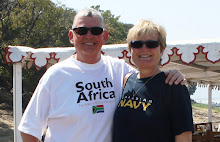It’s said that the former German protectorate of Namibia is the land God made in anger because of its harsh, desolate landscapes.
I had always associated Namibia with miles of endless sand dunes – and of course - the place where Brad and Angelina camped out to await the birth of their daughter.
The twenty-mile drive from the port of Walvis Bay to Swakopmund is spectacular. The paved road is flanked on one side by towering sand dunes with the Atlantic ocean on the other. Beaches are ominously scattered with shipwrecks. And yes, our driver pointed out the Burning Shore resort where Brad and Angelina stayed.
Turning east we made our way into the Namib Desert – no place to break down. A railway runs through the Desert from South Africa into Namibia and up into Angola and is important in the transit of goods, particularly supplies required in the mining of uranium – or yellow cake.

Driving in a convoy of four-wheel drives, our leader would halt our modern day wagon train periodically to point out rock formations and plant life – one of the most unusual species being the Welwitschia, a shrub-like plant which grows just two long strap-shaped leaves continuously throughout its lifetime.
The leaves can grow to be several meters long and become gnarled and twisted from the desert winds.
The plant has a science fiction quality to it and is pollinated by unusual looking insects. It is truly amazing that it survives the arid desert conditions at all - very efficient in the way it finds nourishment, sometimes deriving moisture from coastal sea fogs.
The Namib Desert is the world’s oldest living desert with moon-like landscapes and rocky enclaves worthy of a ready-made movie set for a Cowboy and Indian ambush.
The Desert is home to the world’s largest sand dunes which can shift anywhere between 6-9 feet a year, the second largest of which – Dune 7 – we were able to explore.

Dune 7 didn’t look that foreboding but to try the vertical climb to see the view from the top is more challenging than it looks. For every two steps forward, one retreats a little as sand pours into shoes and any other available opening on one's body. Cameras are particularly vulnerable, and luckily, we had remembered to bring a plastic bag to protect the camera body as much as it could.
The wind whipped up the summit of the dune, creating a temporary mini sand storm against a brilliant blue sky. The colours were amazing, changing in intensity as the sun moved across the sky. Halfway up the dune unable to control our laughter we realized that climbing to its summit was futile so we stopped to take in the view as it stood – sweeping landscapes of golden sand, sculpted by the wind into a Dali-esque beauty.
Climbing down the Dune was abandoned – we sat on our backsides and slid down. We must have walked back on board the ship each with a bucket of sand concealed in our shoes and clothing!
Believe it or not within the starkness of the desert we arrived at a clearing that had at one time been planted with olive trees – and underneath the foliage we were refreshed with sparkling South African wine and Walvis Bay oysters in the half shell.
Sand and all, yet another memorable day.









No comments:
Post a Comment